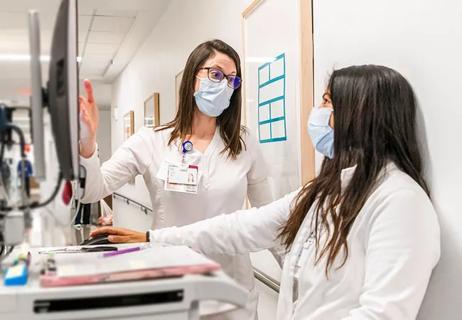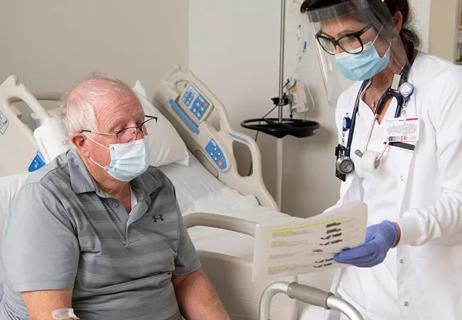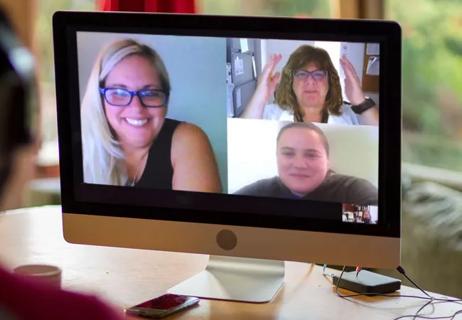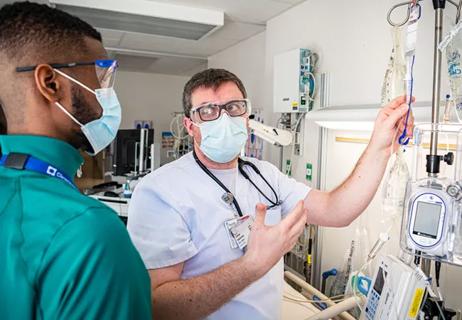Preparing for digital nursing practice

In addition to the Year of the Nurse and Midwife, 2020 has also charted a historical landmark in time related to the transformation of nursing into digital practice.
Cleveland Clinic is a non-profit academic medical center. Advertising on our site helps support our mission. We do not endorse non-Cleveland Clinic products or services. Policy
The COVID-19 pandemic has catapulted nursing into the digital world, embracing a new generation of technology in healthcare. Nurse meetings and networking are happening virtually. Organizations are expanding and enhancing virtual education and training. Telehealth visits have become a new norm. Virtual technology is connecting patients with families and caregivers. And, healthcare is moving in the direction of artificial intelligence (AI) and connected devices, remote monitoring, and more.
Through various forums, executive nurse leaders at the Cleveland Clinic Stanley Shalom Zielony Institute for Nursing Excellence have been focused on educating nursing caregivers – from those who recently graduated nursing school to those who have many years of experience – on this newfound venture into digital nursing practice.
For example, ‘Nursing in a Digital World’ was the theme of the Nursing Institute’s 12th annual Nursing Leadership Summit, which was virtually attended by Cleveland Clinic’s 500+ health system nurse leaders. Additionally, as an active participant in ‘Northeast Ohio Year of the Nurse 2020,’ which includes multiple major health systems, healthcare providers and institutions of higher education, Cleveland Clinic hosted a virtual event in October for Northeast Ohio nurses on preparing for digital nursing practice.
Boasting rich discussions and valuable information, the following includes several key takeaways for nurses from the insightful events.
Cleveland Clinic Virtual Nursing Leadership Summit
Guest speaker Judy Murphy, RN, FACMI, LFIMSS, FAAN, Nurse Executive and Health IT Leader, CNO at IBM Global Healthcare, spoke to attendees about why 2020 is truly the ‘Year of the Nurse,’ how technology and innovation have transformed the role of the nurse at the bedside, in the community and through remote care, how COVID-19 has impacted nursing innovation, and future trends and emerging technologies to assist nurses on the digital journey.
Murphy encouraged attendees to think about health information technology (IT) as the means – not the end – to how healthcare professionals provide and improve care. She discussed the evolution of the electronic health record (EHR), including research that shows nurses are getting more comfortable with the technology, such as making changes to documentation forms, entering information, the implementation of mobile, the movement of WOWs (workstations on wheels), and more. She also discussed continued opportunities to improve the technology’s interoperability and mobilizing data, as well as functionality. She touched on EHR burnout and the need to document more on the plan of care and incorporate things like AI and decision support and using plans of care to support workflow. She explained that nursing is on a digitization journey that stretches beyond implementation of EHR technology to how nurses are using it to deliver better care, noting that AI and analytics will be highly important in the next generation EHR.
She also discussed healthcare’s increased focus on population health and telehealth and the need for nurses to step up and lead the “life care things,” such as changing the way nurses interact with patients, giving patients needed tools, thinking outside the box to pull patients in, and encouraging health and wellness. She talked about collaborative care planning starting with the nurse, and shared decision-making with the patient to create the “life plan” appropriately so patients can manage their health across the continuum. She noted patients documenting their own homecare through patient portals, advances in remote monitoring, the dramatic increase in video visits and consults – and incorporating all of this data into the EHR.
Murphy closed by stating: “There is no better time for nursing to be the one to lead this healthcare team and make sure the patient is an active member as we transition to value-based care, consumerism and patient engagement. We are 3.5 million strong in the U.S. and we can make the difference – the pandemic has set the stage for us.”
In a similarly engaging presentation, Anne Snowdon, BScN, MSc, PhD, FAAN, Professor of Strategy and Entrepreneurship, Academic Chair of the World Health Innovation Network (WIN) and Scientific Director and CEO of SCAN Health, spoke to Cleveland Clinic’s nurse leaders about digital health transformation and the role of nursing in this transformation. She reviewed the Digital Health Indicator Model and how it aligns to nursing practice and leadership. She also discussed the shift of care delivery models, the shifting health system paradigm, as well as the cost of healthcare/impact digital health can have in controlling costs and maximizing reimbursement.
Dr. Snowdon dove into what she called the “drivers of digital transformation,” such as genomics and genetics, information technologies, precision medicine, the generational shift and change in patient care perceptions. She shared insight into her digital health work with HIMSS, including her thorough analysis of everything from adoption of digital tools to how health systems are making it possible for people to help themselves. Her findings determined only 3 percent of health systems to date had successfully achieved interoperability – or being able to interpret data by applying analytics and tracking and tracing outcomes to meaningfully connect digital care with patients and how they define health and wellness.
She encouraged nurse leaders to share her presented information with their staff to see how digital impacts their care. She suggested building the dialogue by debating and thinking about a particular care environment and how nurses can leverage digital for that patient population. To do so, she recommended nurses complete her online rapid assessment, a tool created to develop and support this type of dialogue in terms of the digital capacity identified in a health system. Results are evaluated broadly and showcase strengths and opportunities in various dimensions, in terms of moving forward to a digital health ecosystem. She noted: “Just building that awareness and thinking is a great place to start.”
Northeast Ohio Year of the Nurse 2020 Virtual Event
As Associate Chief Nursing Officer for Nursing Informatics at Cleveland Clinic, I led the discussion for this educational opportunity and focused on a selection of topics that every nurse should know about the transition to digital nursing practice. My presentation introduced nurses to these topics and how they could be applied in their own digital nursing journey. I shared factors that influence digital nursing and associated core abilities, skills, knowledge, engagement and understanding needed for success in digital nursing environments. The discussion was centered on six core drivers for nursing efficiency and practice, which apply to all nursing caregivers in all settings.
The six core drivers and a few associated content examples included:
The key to analytics in healthcare is the value data can provide, including financial, demographic, protected health information, healthcare operations, clinical research and device and clinical data. Harnessing the power of big data is the underpinning of how we will practice moving forward; i.e. data leads to value and value drives revenue, positive patient outcomes and more. Thus, nurses need to embrace their roles as digital architects.
All nurses should have knowledge and understanding of basic data skills, including the three basic types of analytics:
From mobile applications to automated clinical environments and more, patients, families and caregivers are beginning to interact through a fully immersive virtual care experience that is individualized and personalized – and nurses are at the center of this movement. As such, nurses now need to consider things they’ve never before considered, such as on-screen personas, body language and sounds, to create the best possible patient experience.
Additionally, increased use of remote monitoring technologies and devices are on the rise. There are three areas nurses should consider when exploring use of remote monitoring technologies: What device will be used to do the monitoring? How will the device be deployed/type of monitoring? Where will the remote monitoring be applied? Nurses should work to master these digital nursing skills for remote monitoring care:
With emerging technology abundant, it’s important to consider those with the greatest potential in nursing, such as AI, immersive technologies (virtual reality, augmented reality, mixed reality), and more. For example, AI and machine learning technologies leverage intelligent systems and apply logic to provide answers. They evolve with the ability to learn and improve as new information and patterns are recognized. And, the impact of these technologies on nursing is significant – essentially allowing nurses to better practice at the top of their licensure by removing tasks that would otherwise be required of them, which gives nurses the opportunity to focus more on clinical care.
Cybersecurity undermines trust between patients and organizations and trust is the foundation for successful and sustainable business. As nurses are essential in instilling trust and confidence in patients, it is important that nurses familiarize themselves with their organizations’ strategies for healthy online practices. The four types of cybersecurity events that nurses will likely encounter include fraud, ransomware, data breech and denial of service.
Additionally, nurses need to practice good ‘cyber hygiene,’ which are practices that further protect data, privacy and trust. Preventative cyber hygiene is part of physical security and nurses have a professional responsibility to ensure protection of the three greatest areas of cybersecurity weakness: data theft or loss, infection of integrated devices and network password protection.
Nurses’ individual online practices are also important. There are currently five different generations of nurses in the professional nursing workforce – each with different knowledge, use and exposure to social tools. With the nurse’s world more personalized than ever before, online engagement lines can sometimes blur. However, all nurses must uphold their ethical and legal obligation to maintain patient confidentiality at all times. Personal misconduct on social media sites can lead to professional ramifications, including job termination, so mindfulness of personal opinion, affiliations to a nurse’s health system and more, is vital.
IT should be treated like a business – for example, streamlining efficiencies and operations while maintaining focus on the bottom line. Digital nursing leaders have an obligation to remain engaged and informed on digital nursing topics to aid nursing caregivers on these business conversations, which should include discussions on:
Additionally, all nurses have the opportunity to step up into informal digital leader positions, which will enhance patient and caregiver experience and collaboration and communication at all levels and for all care settings.
Byline by Nelita Iuppa, DNP, NEA-BC, RN-BC, FHIMSS, Associate Chief Nursing Officer for Nursing Informatics.

Phone triage system reduces call backs and delays in care

New protocol reduces costs, increases patient and caregiver satisfaction

New options benefit caregivers, nursing units and patients

Nurses facilitate preoperative program to educate and prepare patients for ongoing care

Introduces at-home work and new patient screening tool

Health disparities, mental health and more

Ideas for approaches to prevention, response and more

Educating and developing generations of nurses